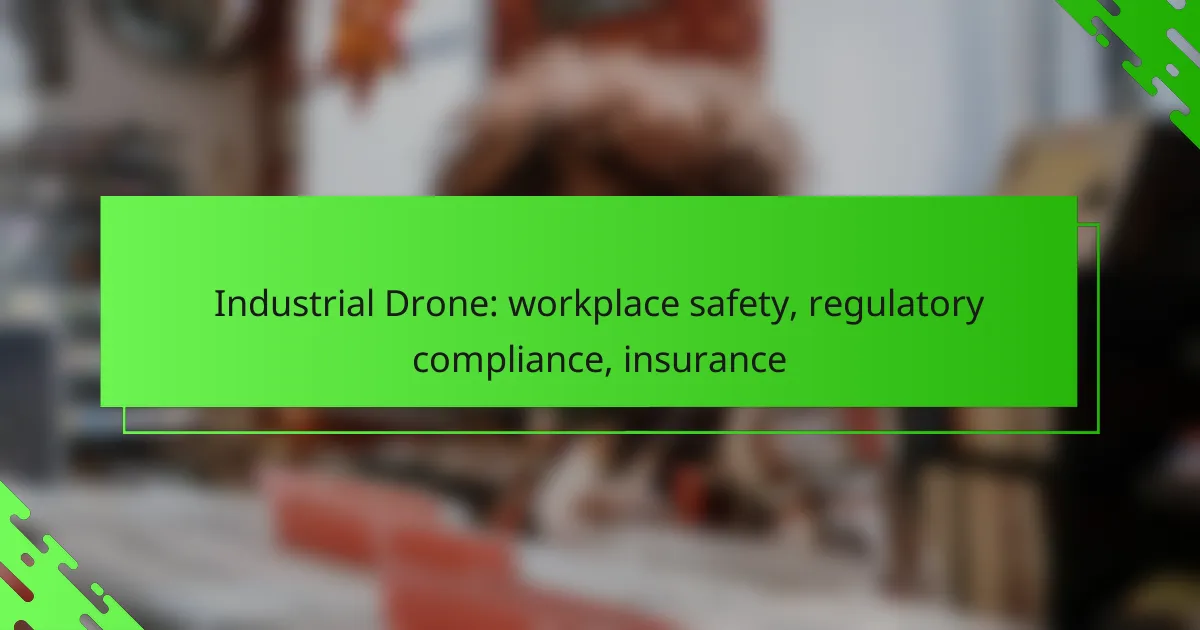Industrial drones play a crucial role in enhancing workplace safety by minimizing human exposure to hazardous environments and enabling real-time monitoring. Compliance with regulatory standards is essential, as it involves adhering to specific laws that govern drone operations, including pilot certification and safety protocols. Additionally, securing appropriate insurance coverage protects businesses from potential financial losses related to accidents and equipment failures.

How do industrial drones enhance workplace safety?
Industrial drones significantly enhance workplace safety by providing advanced monitoring capabilities and reducing human exposure to hazardous environments. These technologies enable real-time data collection and analysis, allowing for proactive safety measures and compliance with regulatory standards.
Real-time hazard detection
Real-time hazard detection is a critical feature of industrial drones, allowing them to identify potential risks such as gas leaks, structural weaknesses, or unsafe working conditions. Equipped with sensors and cameras, drones can monitor environments continuously, providing immediate alerts to safety personnel.
For example, drones can detect toxic gas concentrations in industrial settings, enabling quick evacuations and minimizing health risks. Implementing drones for hazard detection can lead to faster response times and a safer workplace overall.
Automated site inspections
Automated site inspections using drones streamline the process of assessing workplace conditions, ensuring compliance with safety regulations. Drones can cover large areas quickly and capture high-resolution images, allowing for thorough inspections without the need for personnel to enter potentially dangerous zones.
Regular drone inspections can help identify maintenance needs before they escalate into serious issues, reducing downtime and repair costs. Companies can schedule these inspections weekly or monthly, depending on the site’s complexity and regulatory requirements.
Emergency response support
Drones play a vital role in emergency response support by providing real-time situational awareness during incidents. They can quickly survey affected areas, helping first responders assess damage and plan effective interventions.
In emergencies, drones can deliver essential supplies, such as medical kits or communication devices, to inaccessible locations. This capability can significantly enhance the effectiveness of emergency operations, ensuring that help reaches those in need as swiftly as possible.
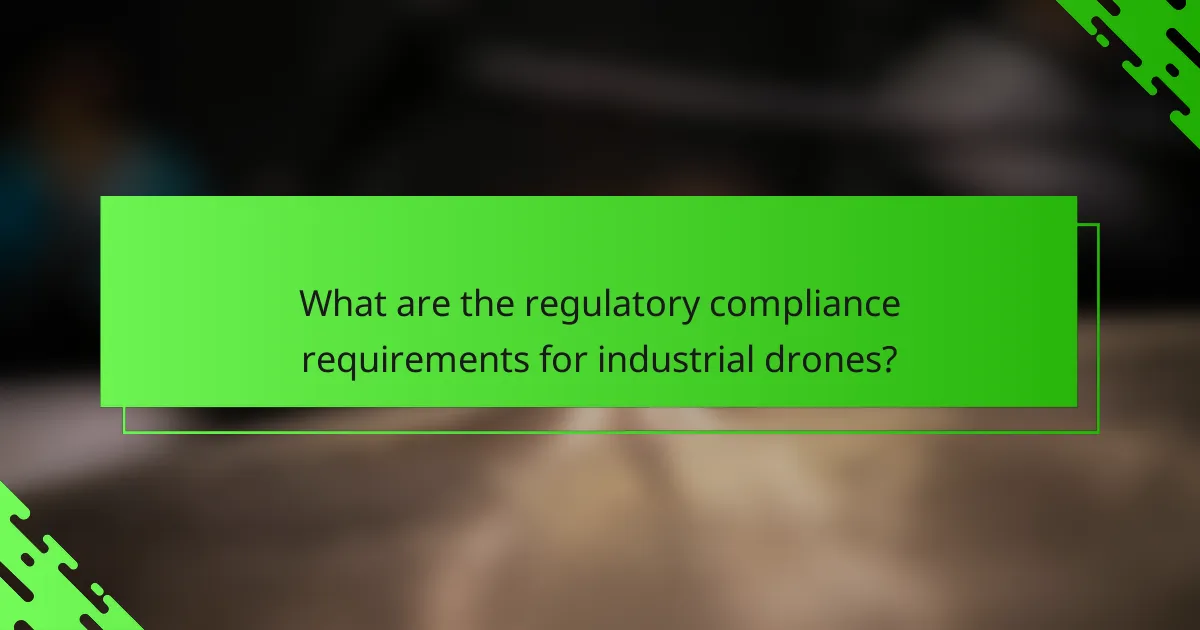
What are the regulatory compliance requirements for industrial drones?
Regulatory compliance for industrial drones involves adhering to specific laws and guidelines set by governing bodies to ensure safe and responsible operation. These requirements can vary significantly by region and include aspects such as pilot certification, operational limits, and safety protocols.
FAA regulations in the United States
The Federal Aviation Administration (FAA) regulates drone operations in the U.S. under Part 107, which outlines the rules for commercial drone use. Operators must obtain a Remote Pilot Certificate and adhere to restrictions such as flying below 400 feet, maintaining visual line of sight, and not flying over people without a waiver.
Additionally, drones must be registered with the FAA if they weigh more than 0.55 pounds. Compliance with these regulations is crucial to avoid fines and ensure safety in the airspace.
EU drone regulations
In the European Union, drone operations are governed by the European Union Aviation Safety Agency (EASA) regulations. These rules categorize drones based on their weight and intended use, requiring different levels of certification and operational permissions. For instance, drones over 250 grams must be registered, and operators need to complete a training course.
Moreover, the EU emphasizes the importance of risk assessment and operational safety, which includes maintaining a safe distance from people and property. Compliance with these regulations is essential for legal operation across EU member states.
Local compliance guidelines
Local compliance guidelines can vary widely depending on state or regional laws. Many jurisdictions have additional requirements, such as obtaining specific permits for commercial drone use or adhering to local privacy laws. It is essential for operators to research and understand these local regulations to avoid legal issues.
For example, some cities may restrict drone flights in urban areas or near critical infrastructure. Checking with local authorities and staying updated on any changes in legislation can help ensure compliance and enhance safety in drone operations.
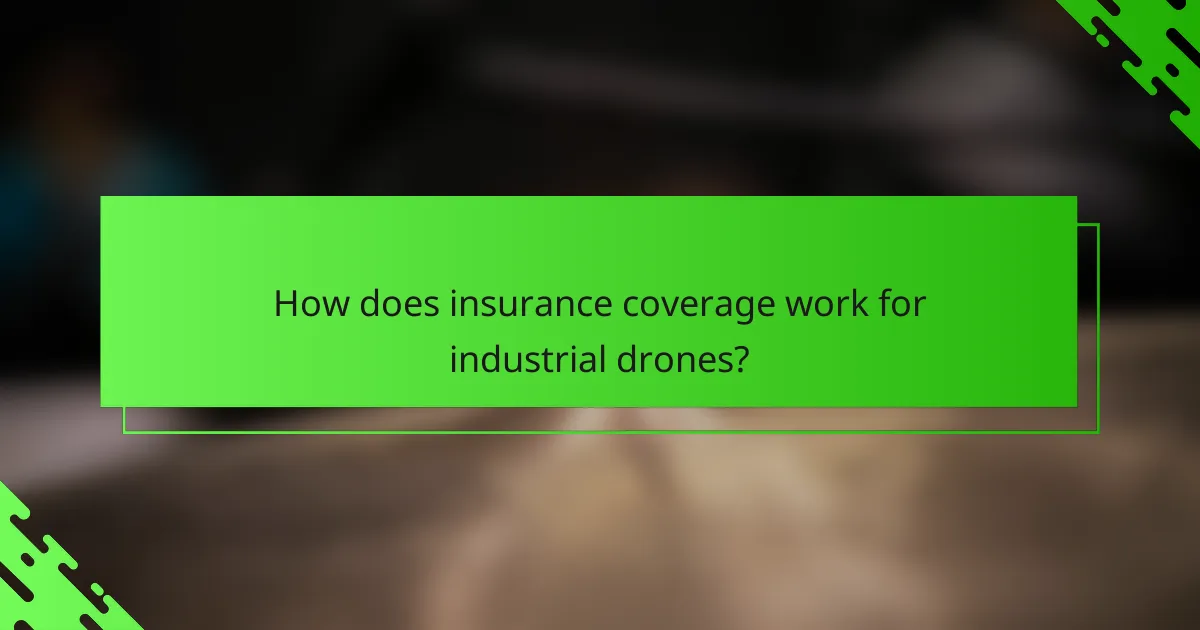
How does insurance coverage work for industrial drones?
Insurance coverage for industrial drones typically includes liability, equipment damage, and operator policies. These coverages help protect businesses from financial losses due to accidents, equipment failures, or regulatory non-compliance.
Liability insurance options
Liability insurance for industrial drones protects against claims arising from injuries or property damage caused by drone operations. Policies can vary widely, with coverage limits often ranging from hundreds of thousands to millions of dollars, depending on the size and scope of operations.
Operators should consider general liability, which covers third-party claims, and aviation liability, which specifically addresses drone-related incidents. It’s crucial to assess the specific risks associated with your operations to choose the right coverage.
Coverage for equipment damage
Equipment damage coverage protects against loss or damage to the drone itself, including crashes, theft, or vandalism. Policies may cover repair costs or replacement value, and premiums can vary based on the drone’s value and usage frequency.
When selecting coverage, consider factors such as the drone’s operating environment and potential hazards. Some policies may offer additional coverage for payloads or specialized equipment attached to the drone.
Policy considerations for operators
Operators should carefully review policy terms, including exclusions and deductibles, to ensure adequate protection. Understanding the specific requirements for commercial drone operations, such as compliance with FAA regulations in the U.S. or EASA regulations in Europe, is essential for securing appropriate coverage.
Additionally, operators should keep detailed records of their drone operations, maintenance, and any incidents, as this documentation can be crucial when filing claims. Regularly reassessing insurance needs as operations expand or change can help maintain adequate coverage.
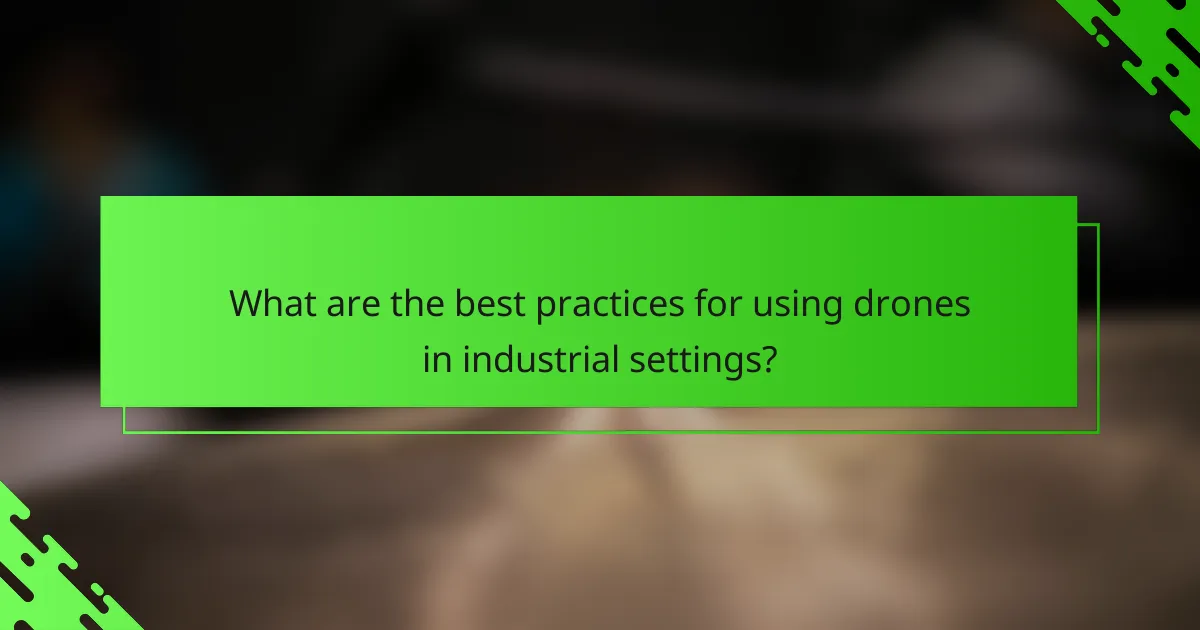
What are the best practices for using drones in industrial settings?
Best practices for using drones in industrial settings focus on ensuring safety, compliance with regulations, and protecting sensitive data. Implementing structured protocols can mitigate risks and enhance operational efficiency.
Regular maintenance protocols
Regular maintenance of drones is crucial to ensure their safe and efficient operation in industrial environments. This includes routine inspections, software updates, and battery checks to prevent malfunctions during flights.
Establish a maintenance schedule based on usage frequency, typically every few weeks or after a set number of flight hours. Document all maintenance activities to maintain compliance with regulatory standards.
Operator training requirements
Training operators is essential for safe drone operation in industrial settings. Operators should complete a certified training program that covers flight safety, equipment handling, and emergency procedures.
Consider ongoing training sessions to keep operators updated on new technologies and regulations. This can include simulations and hands-on practice to reinforce skills and ensure confidence in real-world scenarios.
Data security measures
Data security is vital when using drones, especially in industries handling sensitive information. Implement encryption protocols for data transmission and storage to protect against unauthorized access.
Regularly review data access permissions and ensure that only authorized personnel can handle drone-collected data. Establish clear policies for data retention and disposal to comply with industry regulations.

How do industrial drones compare to traditional safety methods?
Industrial drones offer significant advantages over traditional safety methods by enhancing efficiency, reducing costs, and improving data accuracy. They can perform inspections and monitor environments more quickly and safely than manual methods, minimizing risks to workers.
Cost-effectiveness analysis
Using industrial drones can lead to substantial cost savings compared to traditional safety methods. Initial investments in drone technology may be higher, but operational costs tend to decrease due to reduced labor and time requirements. For instance, drone inspections can cut down inspection times from hours to minutes, translating to lower labor costs.
Additionally, drones can help prevent costly accidents by identifying hazards before they lead to incidents. This proactive approach can save companies from potential fines and legal fees associated with workplace injuries.
Efficiency in data collection
Industrial drones excel in data collection, providing high-resolution imagery and real-time data analysis. They can cover large areas quickly, capturing comprehensive data that would take significantly longer using traditional methods. For example, a drone can survey a construction site in a fraction of the time it would take a team on foot.
Moreover, drones can be equipped with various sensors to gather specific data types, such as thermal imaging for detecting heat loss or structural weaknesses. This versatility allows for more informed decision-making and timely interventions.
Impact on worker safety
Implementing drones in industrial settings greatly enhances worker safety by minimizing their exposure to hazardous environments. Drones can perform inspections in dangerous areas, such as high elevations or toxic zones, reducing the need for workers to enter these risky locations.
Furthermore, the use of drones can lead to a cultural shift towards prioritizing safety in the workplace. Companies that adopt drone technology often see a decrease in accident rates, fostering a safer working environment overall.
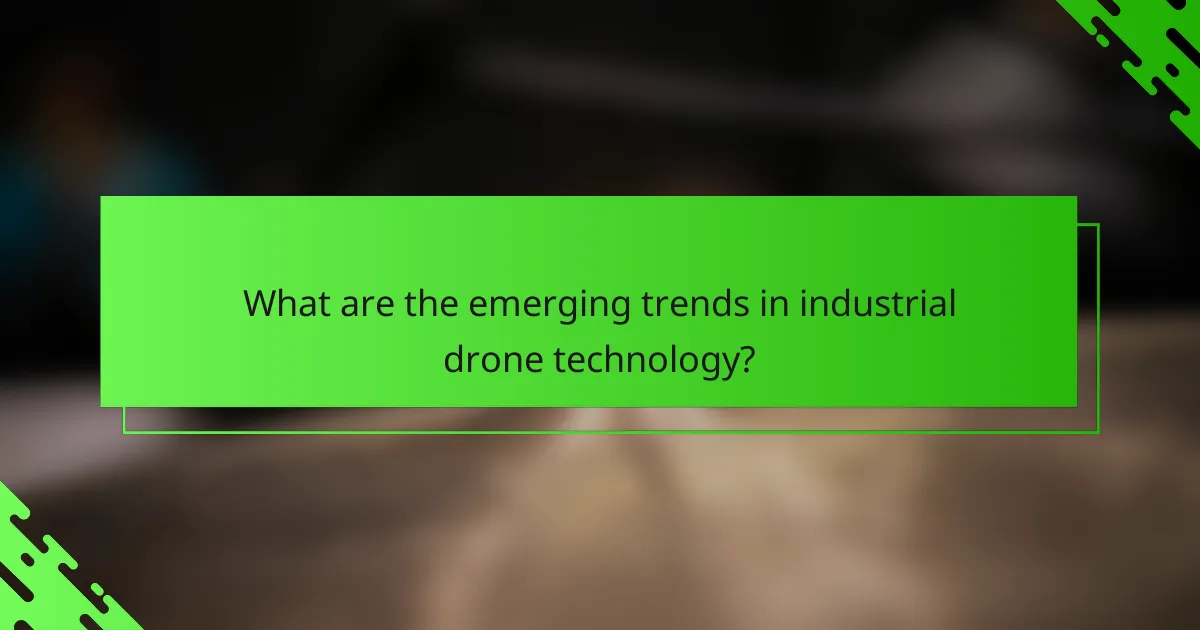
What are the emerging trends in industrial drone technology?
Emerging trends in industrial drone technology focus on enhancing efficiency, safety, and compliance through advanced features. Key developments include the integration of artificial intelligence, improvements in battery life, and increased regulatory frameworks to ensure safe operations in various industries.
Integration with AI and machine learning
The integration of AI and machine learning into industrial drones significantly enhances their operational capabilities. These technologies enable drones to analyze data in real-time, improving decision-making processes and automating tasks such as inspections and monitoring.
For example, drones equipped with AI can identify defects in infrastructure or machinery by processing images and sensor data, leading to quicker and more accurate assessments. This capability not only boosts productivity but also reduces the need for human intervention in hazardous environments.
Advancements in battery life
Advancements in battery technology are crucial for extending the operational range and efficiency of industrial drones. New battery designs and materials are enabling drones to fly longer, with some models achieving flight times exceeding 30 minutes under optimal conditions.
These improvements allow for more extensive coverage during inspections or deliveries, minimizing downtime for battery swaps. Companies should consider the trade-offs between battery life and payload capacity, as heavier loads may reduce flight duration. Regular maintenance and monitoring of battery health are essential to ensure optimal performance and safety.
